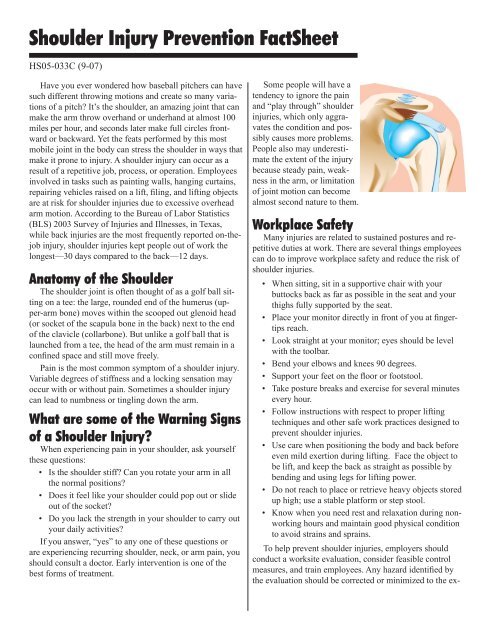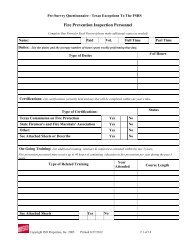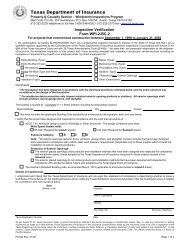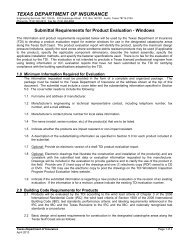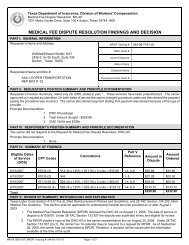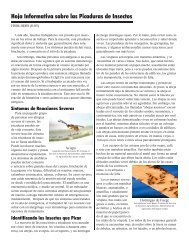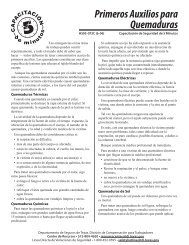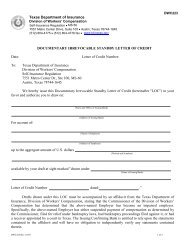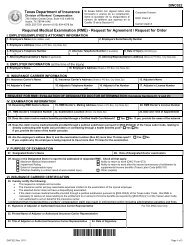Shoulder Injury Prevention FactSheet - Texas Department of Insurance
Shoulder Injury Prevention FactSheet - Texas Department of Insurance
Shoulder Injury Prevention FactSheet - Texas Department of Insurance
Create successful ePaper yourself
Turn your PDF publications into a flip-book with our unique Google optimized e-Paper software.
<strong>Shoulder</strong> <strong>Injury</strong> <strong>Prevention</strong> <strong>FactSheet</strong><br />
HS05-033C (9-07)<br />
Have you ever wondered how baseball pitchers can have<br />
such different throwing motions and create so many variations<br />
<strong>of</strong> a pitch? It’s the shoulder, an amazing joint that can<br />
make the arm throw overhand or underhand at almost 100<br />
miles per hour, and seconds later make full circles frontward<br />
or backward. Yet the feats performed by this most<br />
mobile joint in the body can stress the shoulder in ways that<br />
make it prone to injury. A shoulder injury can occur as a<br />
result <strong>of</strong> a repetitive job, process, or operation. Employees<br />
involved in tasks such as painting walls, hanging curtains,<br />
repairing vehicles raised on a lift, filing, and lifting objects<br />
are at risk for shoulder injuries due to excessive overhead<br />
arm motion. According to the Bureau <strong>of</strong> Labor Statistics<br />
(BLS) 2003 Survey <strong>of</strong> Injuries and Illnesses, in <strong>Texas</strong>,<br />
while back injuries are the most frequently reported on-thejob<br />
injury, shoulder injuries kept people out <strong>of</strong> work the<br />
longest—30 days compared to the back—12 days.<br />
Anatomy <strong>of</strong> the <strong>Shoulder</strong><br />
The shoulder joint is <strong>of</strong>ten thought <strong>of</strong> as a golf ball sitting<br />
on a tee: the large, rounded end <strong>of</strong> the humerus (upper-arm<br />
bone) moves within the scooped out glenoid head<br />
(or socket <strong>of</strong> the scapula bone in the back) next to the end<br />
<strong>of</strong> the clavicle (collarbone). But unlike a golf ball that is<br />
launched from a tee, the head <strong>of</strong> the arm must remain in a<br />
confined space and still move freely.<br />
Pain is the most common symptom <strong>of</strong> a shoulder injury.<br />
Variable degrees <strong>of</strong> stiffness and a locking sensation may<br />
occur with or without pain. Sometimes a shoulder injury<br />
can lead to numbness or tingling down the arm.<br />
What are some <strong>of</strong> the Warning Signs<br />
<strong>of</strong> a <strong>Shoulder</strong> <strong>Injury</strong>?<br />
When experiencing pain in your shoulder, ask yourself<br />
these questions:<br />
• Is the shoulder stiff? Can you rotate your arm in all<br />
the normal positions?<br />
• Does it feel like your shoulder could pop out or slide<br />
out <strong>of</strong> the socket?<br />
• Do you lack the strength in your shoulder to carry out<br />
your daily activities?<br />
If you answer, “yes” to any one <strong>of</strong> these questions or<br />
are experiencing recurring shoulder, neck, or arm pain, you<br />
should consult a doctor. Early intervention is one <strong>of</strong> the<br />
best forms <strong>of</strong> treatment.<br />
Some people will have a<br />
tendency to ignore the pain<br />
and “play through” shoulder<br />
injuries, which only aggravates<br />
the condition and possibly<br />
causes more problems.<br />
People also may underestimate<br />
the extent <strong>of</strong> the injury<br />
because steady pain, weakness<br />
in the arm, or limitation<br />
<strong>of</strong> joint motion can become<br />
almost second nature to them.<br />
Workplace Safety<br />
Many injuries are related to sustained postures and repetitive<br />
duties at work. There are several things employees<br />
can do to improve workplace safety and reduce the risk <strong>of</strong><br />
shoulder injuries.<br />
• When sitting, sit in a supportive chair with your<br />
buttocks back as far as possible in the seat and your<br />
thighs fully supported by the seat.<br />
• Place your monitor directly in front <strong>of</strong> you at fingertips<br />
reach.<br />
• Look straight at your monitor; eyes should be level<br />
with the toolbar.<br />
• Bend your elbows and knees 90 degrees.<br />
• Support your feet on the floor or footstool.<br />
• Take posture breaks and exercise for several minutes<br />
every hour.<br />
• Follow instructions with respect to proper lifting<br />
techniques and other safe work practices designed to<br />
prevent shoulder injuries.<br />
• Use care when positioning the body and back before<br />
even mild exertion during lifting. Face the object to<br />
be lift, and keep the back as straight as possible by<br />
bending and using legs for lifting power.<br />
• Do not reach to place or retrieve heavy objects stored<br />
up high; use a stable platform or step stool.<br />
• Know when you need rest and relaxation during nonworking<br />
hours and maintain good physical condition<br />
to avoid strains and sprains.<br />
To help prevent shoulder injuries, employers should<br />
conduct a worksite evaluation, consider feasible control<br />
measures, and train employees. Any hazard identified by<br />
the evaluation should be corrected or minimized to the ex-
tent feasible. Engineering controls (work station redesign,<br />
adjustable fixtures, or tool redesign) and administrative<br />
controls (changes in procedures, job rotation, work pacing,<br />
or breaks) are alternatives that should be considered.<br />
Minimizing the Pain <strong>of</strong> an <strong>Injury</strong><br />
After injuring your shoulder, pain is a useful indicator to<br />
guide how much to use it. Unless your doctor or physical<br />
therapist gives you other instructions, limit activities and<br />
arm motions that are aggravating the pain. The following<br />
are some specific suggestions to help minimize the pain <strong>of</strong><br />
a shoulder injury:<br />
• Eliminate heavy lifting and raising arms above shoulders.<br />
• Lift items close to the body.<br />
• Only lift light weights and only below shoulder level.<br />
• Practice good posture when doing computer work, assembly<br />
work, or other activities that involve the arms.<br />
• Limit the amount <strong>of</strong> time that you restrict arm movement<br />
with a sling, as you can develop frozen shoulder<br />
(stiff shoulder joint).<br />
improve, the diameter <strong>of</strong> the swing may be increased.<br />
Initially perform the exercise with just the weight <strong>of</strong><br />
your arm. As shoulder pain improves, progressively<br />
add more weight—5 to 10 pounds (a filled gallon<br />
container weighs 8 pounds). Perform exercise for five<br />
minutes once or twice a day.<br />
• Perform muscle-strengthening exercises. After<br />
sustaining a shoulder injury, begin shoulder-muscle<br />
toning exercises about one to two weeks after doing<br />
pendulum stretching exercises. Use elastic exercise<br />
bands for a variety <strong>of</strong> arm exercises. For example, attach<br />
band to a doorknob. Then hold your elbow close<br />
to your side at a 90-degree angle, grasp the band and<br />
pull toward your waist. Hold for five seconds. Do 15<br />
to 20 repetitions each day.<br />
This fact sheet was published with information from<br />
the Harvard Medical School’s Consumer Health Information,<br />
the University <strong>of</strong> Pittsburgh Medical Center, and the<br />
<strong>Texas</strong> <strong>Department</strong> <strong>of</strong> <strong>Insurance</strong> (TDI), Division <strong>of</strong> Workers’<br />
Compensation (DWC) and is considered factual at the time<br />
<strong>of</strong> publication.<br />
Exercise to Maintain Healthy <strong>Shoulder</strong>s<br />
Keeping physically fit with a balanced program <strong>of</strong> aerobic<br />
exercise and stretching and strengthening all body parts<br />
can help to prevent shoulder injuries. If you think you have<br />
injured your shoulder, consult a doctor or physical therapist<br />
before starting an exercise program. The following practices<br />
can prevent injury by warming-up shoulders before<br />
exercise or work:<br />
• Apply heat to shoulder muscles prior to exercise.<br />
Heat prepares muscles and tendons for exercise. For<br />
example, take a warm shower for 10 to 15 minutes<br />
before exercise.<br />
• Keep arm below shoulder height while doing arm<br />
stretches.<br />
• Gradually increase movements during shoulder<br />
warm-up—big circles, across-body movements, trunk<br />
twists, shoulder blade rolls and forward and backward<br />
squeezes.<br />
• While sitting or standing, keep arm vertical and close<br />
to body. Pendulum stretching exercises relieve pressure<br />
on the rotator cuff. Allow arm to swing back and<br />
forth in a small diameter (about 1 inch). As symptoms<br />
The <strong>Texas</strong> <strong>Department</strong> <strong>of</strong> <strong>Insurance</strong>,<br />
Division <strong>of</strong> Workers’ Compensation (TDI, DWC)<br />
E-mail resourcecenter@tdi.state.tx.us<br />
or call 1-800-687-7080 for more information.<br />
Safety Violations Hotline<br />
1-800-452-9595<br />
safetyhotline@tdi.state.tx.us


